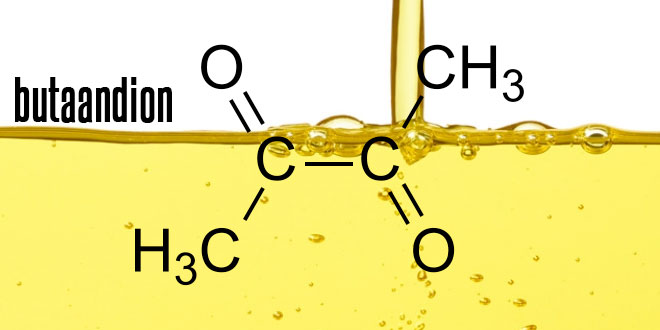Is butanedion, used in some e-liquids to be hazardous to health?

Is butanedione used in some e-liquids dangerous to health?
What is butanedione?
Butanedion or diacetyl is a substance with intense butter flavor. It is found in low concentrations in natural products such as coffee, apples, honey and vinegar. Because of its typical butter flavor, butanedione is frequently used in the food industry. Just think of vegetable oil and fat products that must have a buttery flavor. Under the influence of yeast, butanedion or diacetyl is also produced as a by-product in the production of beer when glucose is converted into ethanol. It is obvious that this fabric is also popular with e-liquid manufacturers, which of course benefits from the launch of the best or tastiest juices.
Toxicology and safety of butanedione
Butaandion is labeled as "safe" by the Food and Drug Administration, but this refers only to intake via our diet. How to handle inhalation of butanedion when ejecting an electronic cigarette is another story.
It is almost certain that there is a relationship between working with butanedione as artificial butter aroma and the lung disease bronchiolitis obliterans. This is a life-threatening pulmonary disease that narrows the bronchioles through the formation of tissue. The only remedy for surviving this disease is a lung transplant. The risk of the disease is mainly when the substance is heated and in the vapors for long periods of time.
The ball is starting to roll in response to an affair in a Missouri factory where microwave popcorn is produced. Hence the disease is often called popcorn long. Following a series of complaints, a study was found that showed that nearly 20 of the 135 employees of the popcorn factory showed abnormal lung function and the risk of airway obstruction was 3 times higher than normal. The study showed that heating and prolonged inhalation of butanedion fumes - the substance to give a delicious buttery flavor to popcorn - was responsible for these problems. In this case, millions of dollars were paid in damages.
The use of butanedione in e-liquids
When electronic smoking was still in its infancy, butanedion was used to give e-liquids that gave a tasty buttery flavor. Dampers who use or used this kind of e-liquor will be able to confirm that butaandion is a true 'taste upgrade', the cherry on the cake as it were.
Partly due to the increasing popularity of electronic cigarettes, a wider public that came into contact with e-liquids and thus more knowledge among users, this use was quickly questioned. Opponents also found a quick partner in butaandion to nail the electronic cigarette to the scandal.
It must have been around 2011 - our first steps in the vapor world - when the specialized forums were flooded with critical questions around this theme.
At first this seemed to have a positive effect on the different producers. Most manufacturers removed butanedione from their e-liquids and their marketing divisions used to advertise their e-liquid as "butanedion-free".
In 2014 Dr. Konstantinos Farsalinos - from the Onassis Cardiac Surgery Center in Athens - a study of the presence of methyl methacrylate and butanedione in e-liquids. In his research, he examined 159 sweet e-liquids from 36 European and American manufacturers and showed that 74.2% of samples tested positive for the presence of these chemicals. 47.3% of the positive samples contain levels (slightly) higher than the National Institute of Occupational Safety and Health (NIOSH) approves.
The study of Dr. Farsalinos thus showed that despite the claims of the manufacturers and despite the tests they claimed to perform, there were still substances in their e-liquids that actually did not belong at home.
Farsalinos' research has undoubtedly caused some e-liquid producers. Some e-cigarette groups today impose on their members the obligation to carry out tests on their liquids, but unfortunately, this can not be guaranteed for all manufacturers. In short, as long as there is no legal framework to regulate this, it is almost impossible for the user to find out if there is butanedione present in his e-liquid.
Should vapors worry?
The safety limit set by NIOSH includes the amount of exposure that would cause 1 to 1000 employees of lung dysfunction after 45 years of exposure. Dr. Farsalinos emphasized that a risk of 1 in 1000 to develop lung dysfunction is still a phenomenal advantage over smokers who have almost a chance of having 1 to 3 to during
Thanks for this article, following you!
np and follow you back now